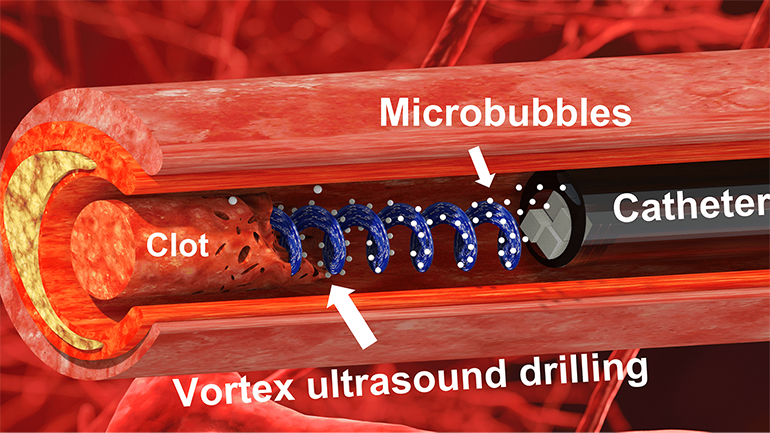A team of researchers at North Carolina State University have developed an ultrasound transducer that can disrupt blood clots in the brain quickly by creating an ultrasound vortex or ‘tornado’. The transducer is designed to be housed in a catheter that can be advanced through the vasculature until it reaches the site of a blood clot in the brain, such as those that occur in cases of cerebral venous sinus thrombosis. The technique can disrupt clots more quickly than conventional forward-facing ultrasounds, as the vortex wave creates shear stress that helps to break the clot into pieces. The approach has the potential to disrupt clots much more quickly than pharmaceutical approaches, albeit with more procedural complexity.
Cerebral venous sinus thrombosis (CVST) occurs when a blood clot blocks a vein that drains blood from the brain. Clearly, this is a medical emergency and time is of the essence. However, many existing techniques to treat the condition involve trying to dissolve the clot, potentially through the use of clot busting drugs, but these approaches tend to take a long time. This latest technology aims to reduce this time significantly.
“Based on available data, pharmaceutical interventions to dissolve CVST blood clots take at least 15 hours, and average around 29 hours,” said Chengzhi Shi, a researcher involved in the study. “During in vitro testing, we were able to dissolve an acute blood clot in well under half an hour. The fact that our new technique works quickly is important because CVST clots increase pressure on blood vessels in the brain. This increases the risk of a hemorrhage in the brain, which can be catastrophic for patients.”
Using acoustic waves to break clots apart has the potential to work much faster than thrombolytic drugs, but forward-facing ultrasound systems may not be the most efficient way to achieve this. “Our previous work looked at various techniques that use ultrasound to eliminate blood clots using what are essentially forward-facing waves,” said Xiaoning Jiang, another researcher involved in the study. “Our new work uses vortex ultrasound, where the ultrasound waves have a helical wavefront.
So far, the researchers have tested the system in vitro with cow blood in a 3D-printed cerebral venous sinus model, and showed that the ultrasound tornado could disrupt clots quickly. They also tested if the helical ultrasound caused damage to blood vessels using animal blood vessels, and found that the technique appears not to disrupt healthy tissue.
Study in journal Research: A model of high-speed endovascular sonothrombolysis with vortex ultrasound-induced shear stress to treat cerebral venous sinus thrombosis
